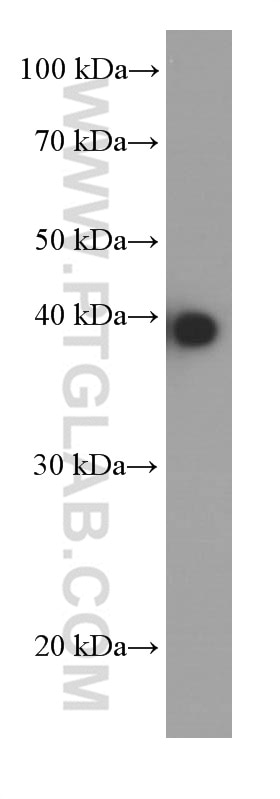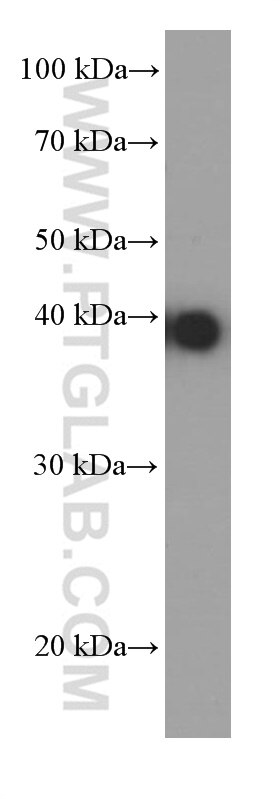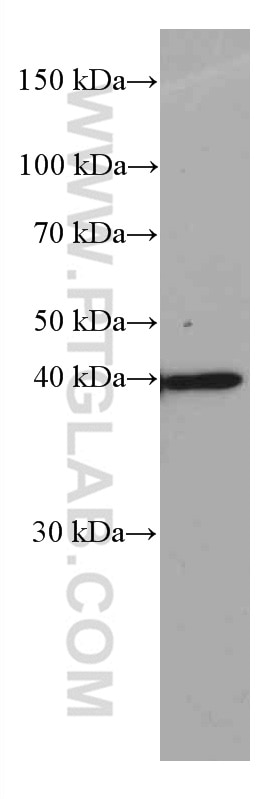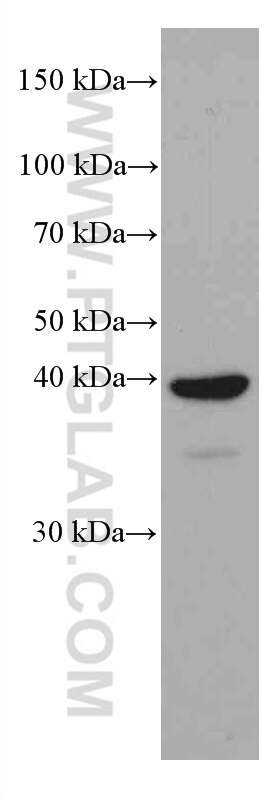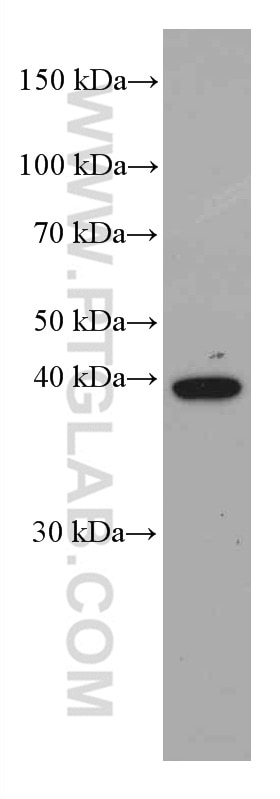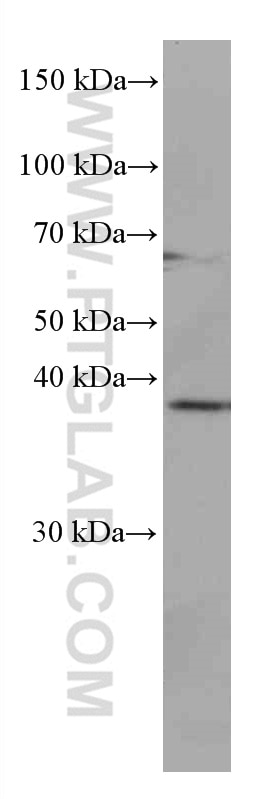Anticorps Monoclonal anti-JUN
JUN Monoclonal Antibody for WB, ELISA
Hôte / Isotype
Mouse / IgG1
Réactivité testée
Humain, rat, souris
Applications
WB, ELISA
Conjugaison
Non conjugué
CloneNo.
1G6B11
N° de cat : 66313-1-Ig
Synonymes
Galerie de données de validation
Applications testées
| Résultats positifs en WB | cellules RAW 264.7, cellules A431, cellules Jurkat, cellules NIH/3T3, cellules ROS1728 |
Dilution recommandée
| Application | Dilution |
|---|---|
| Western Blot (WB) | WB : 1:1000-1:8000 |
| It is recommended that this reagent should be titrated in each testing system to obtain optimal results. | |
| Sample-dependent, check data in validation data gallery | |
Applications publiées
| KD/KO | See 1 publications below |
| WB | See 20 publications below |
Informations sur le produit
66313-1-Ig cible JUN dans les applications de WB, ELISA et montre une réactivité avec des échantillons Humain, rat, souris
| Réactivité | Humain, rat, souris |
| Réactivité citée | rat, Humain, souris |
| Hôte / Isotype | Mouse / IgG1 |
| Clonalité | Monoclonal |
| Type | Anticorps |
| Immunogène | JUN Protéine recombinante Ag17639 |
| Nom complet | jun oncogene |
| Masse moléculaire calculée | 331 aa, 36 kDa |
| Poids moléculaire observé | 39 kDa |
| Numéro d’acquisition GenBank | BC068522 |
| Symbole du gène | JUN |
| Identification du gène (NCBI) | 3725 |
| Conjugaison | Non conjugué |
| Forme | Liquide |
| Méthode de purification | Purification par protéine G |
| Tampon de stockage | PBS avec azoture de sodium à 0,02 % et glycérol à 50 % pH 7,3 |
| Conditions de stockage | Stocker à -20°C. Stable pendant un an après l'expédition. L'aliquotage n'est pas nécessaire pour le stockage à -20oC Les 20ul contiennent 0,1% de BSA. |
Informations générales
What is the molecular weight of JUN?
The molecular weight of JUN is approximately 39 kDa.
What is the cellular localization of JUN?
JUN expression can be located in the nucleus. However, ubiquitinated JUN colocalizes with lysosomal proteins (PMID: 15469925).
What is the function of JUN?
JUN is a basic leucine zipper (bZIP) transcription factor that recognizes and binds to a consensus heptamer motif of 5'-TGA[CG]TCA-3' in the enhancer region of target genes. JUN acts as either a homo- or heterodimer and binds to the DNA to regulate transcriptional activity, specifically promoting the activity of NR5A1 when phosphorylated by HIPK3, leading to increased steroidogenic gene expression upon the stimulation of the cAMP signaling pathway (PMID: 9732876).
What post-translational modifications is JUN subjected to?
JUN is acetylated at Lys-271 by EP300 (PMID: 11689449). JUN is phosphorylated by PLK3 following exposure to hypoxia or UV irradiation, which leads to increased DNA-binding activity (PMID: 27281822), and also by PAK2 at numerous threonine residues to promote cell proliferation and transformation (PMID: 21177766). JUN is also phosphorylated by DYRK2 at Ser-243, which primes it for subsequent further phosphorylation by GSK3B and reduces its ability to bind DNA (PMID: 22307329).
What is the role of JUN in disease?
Activation of JUN is linked with proliferation and angiogenesis in invasive breast cancers (PMID: 16733206).
Protocole
| Product Specific Protocols | |
|---|---|
| WB protocol for JUN antibody 66313-1-Ig | Download protocol |
| Standard Protocols | |
|---|---|
| Click here to view our Standard Protocols |
Publications
| Species | Application | Title |
|---|---|---|
Cell Biol Toxicol microRNA-149-5p mediates the PM2.5-induced inflammatory response by targeting TAB2 via MAPK and NF-κB signaling pathways in vivo and in vitro. | ||
Genomics Integrative epigenomic profiling reveal AP-1 is a key regulator in intrahepatich cholangiocarcinoma. | ||
Pharmacol Res CX-5461 is a potent immunosuppressant which inhibits T cell-mediated alloimmunity via p53-DUSP5. | ||
J Cell Physiol Lack of Mof reduces acute liver injury by enhancing transcriptional activation of Igf1. | ||
Front Pharmacol Azithromycin Attenuates Bleomycin-Induced Pulmonary Fibrosis Partly by Inhibiting the Expression of LOX and LOXL-2. |
